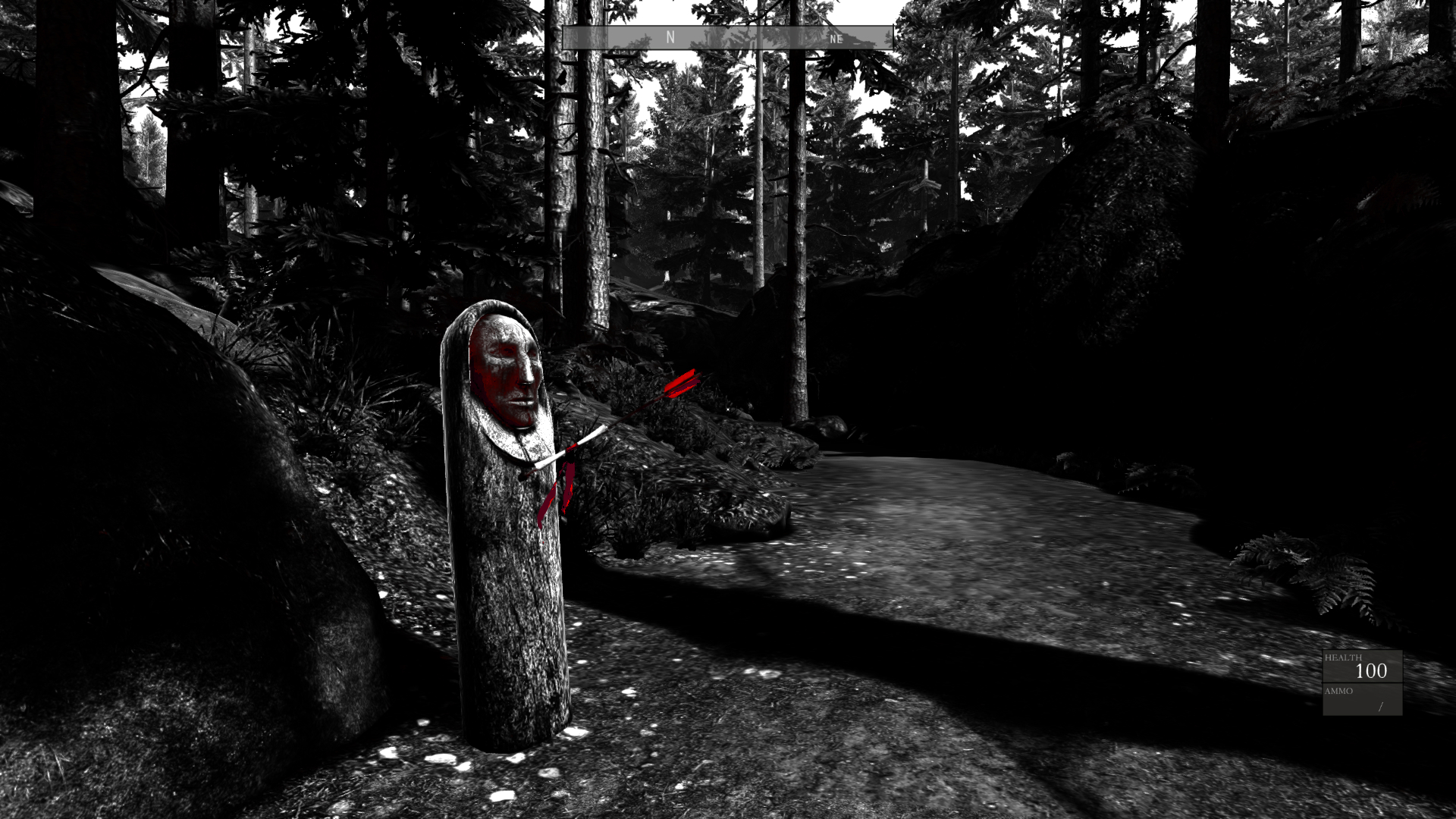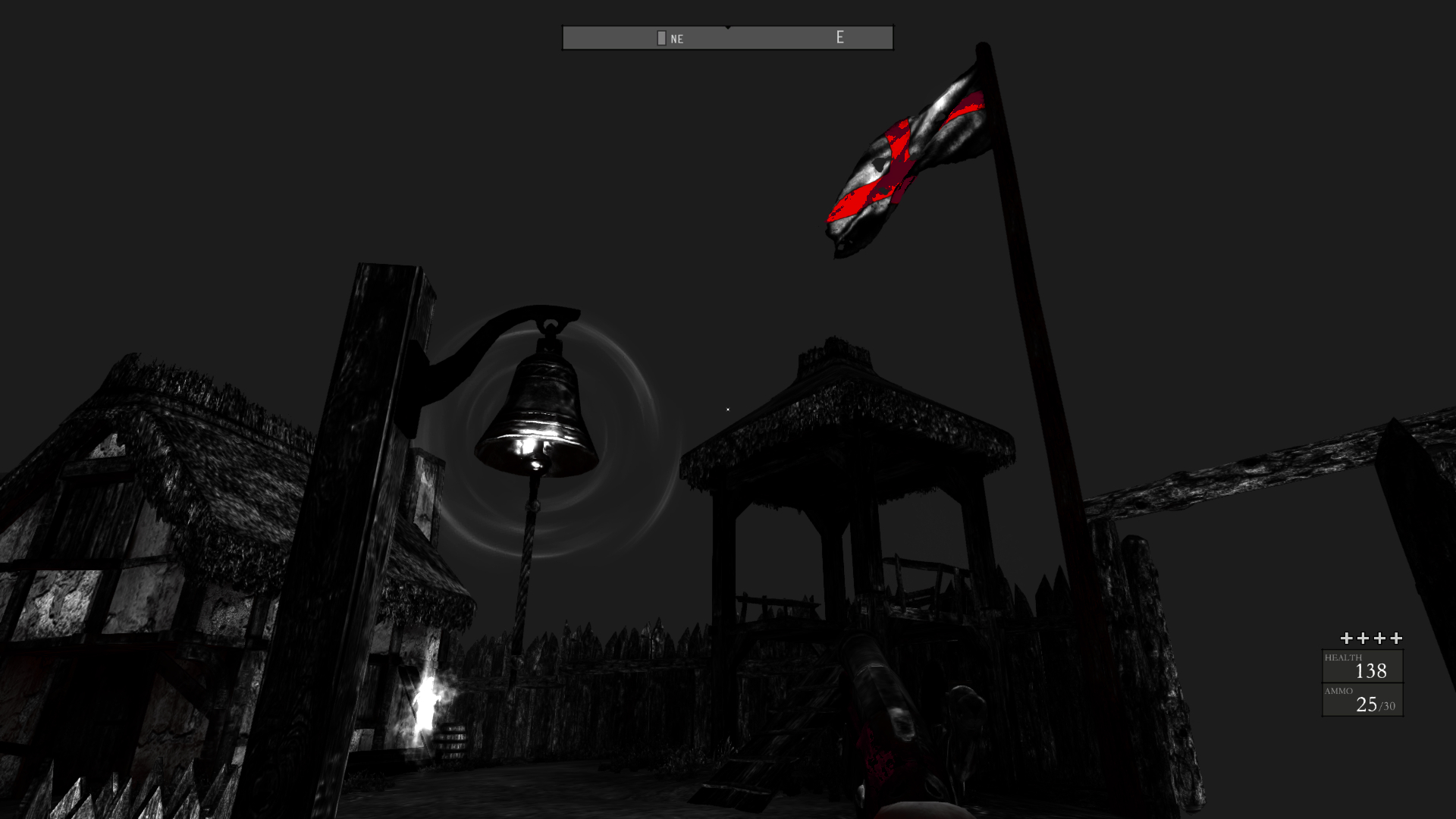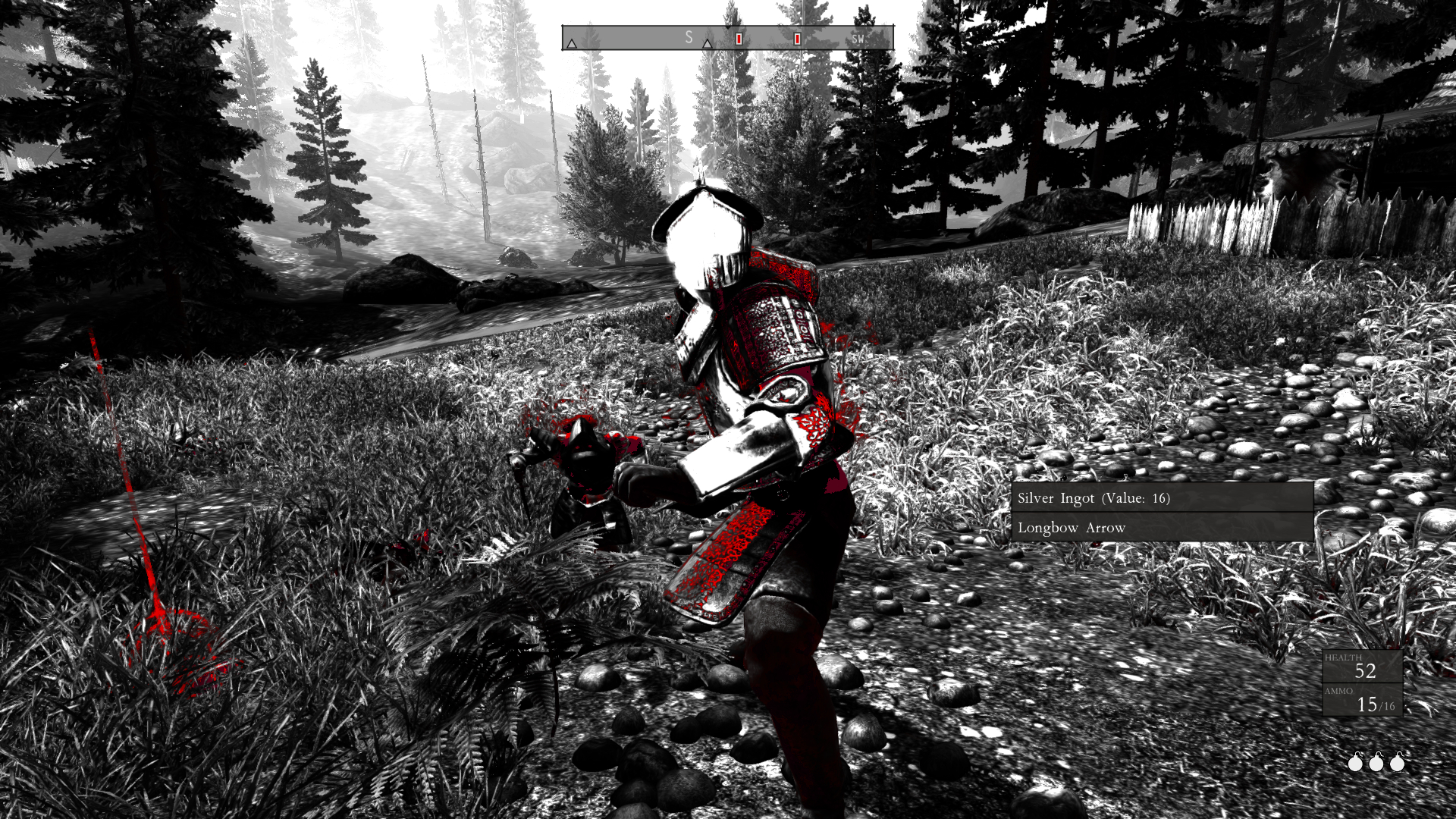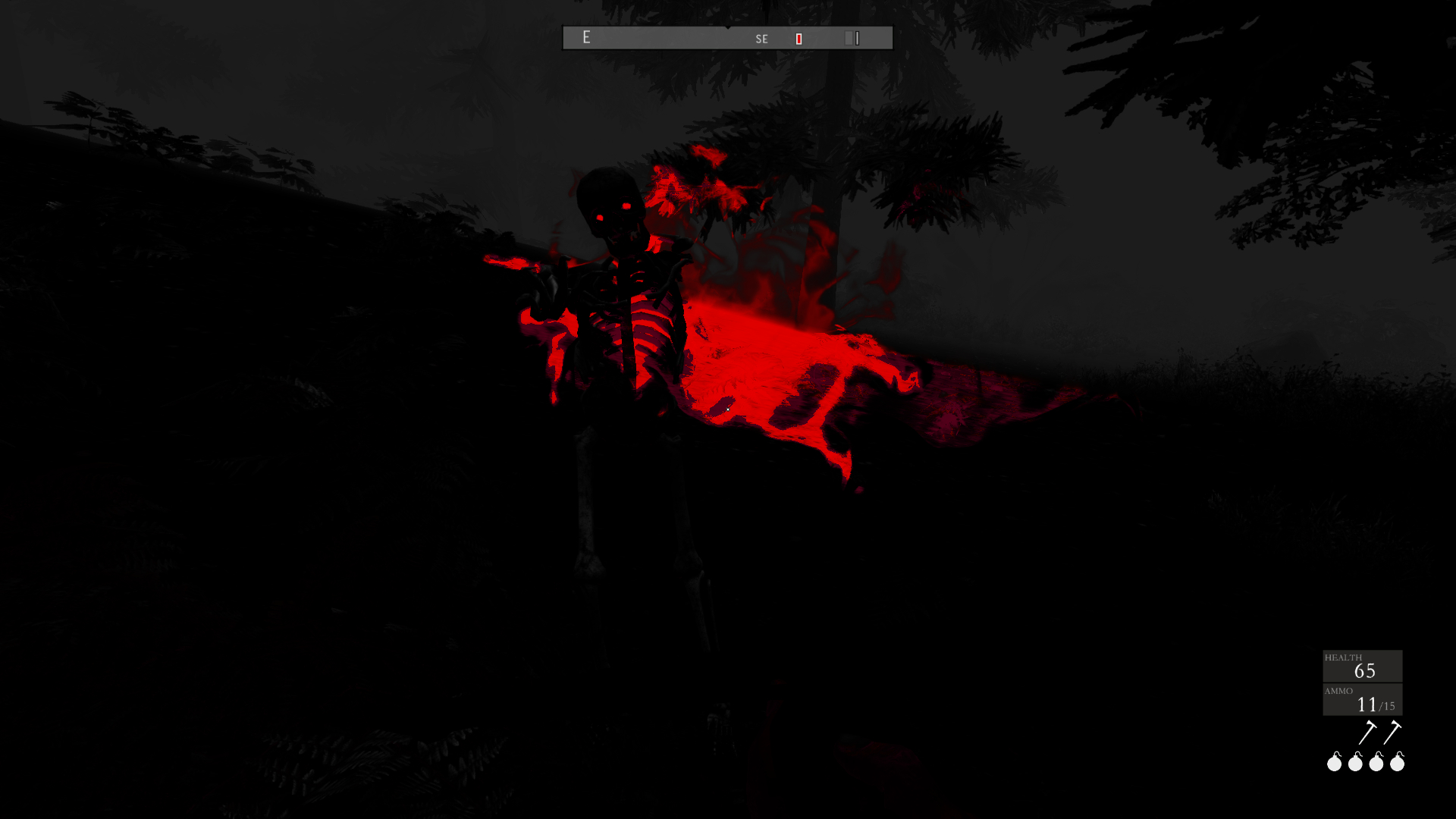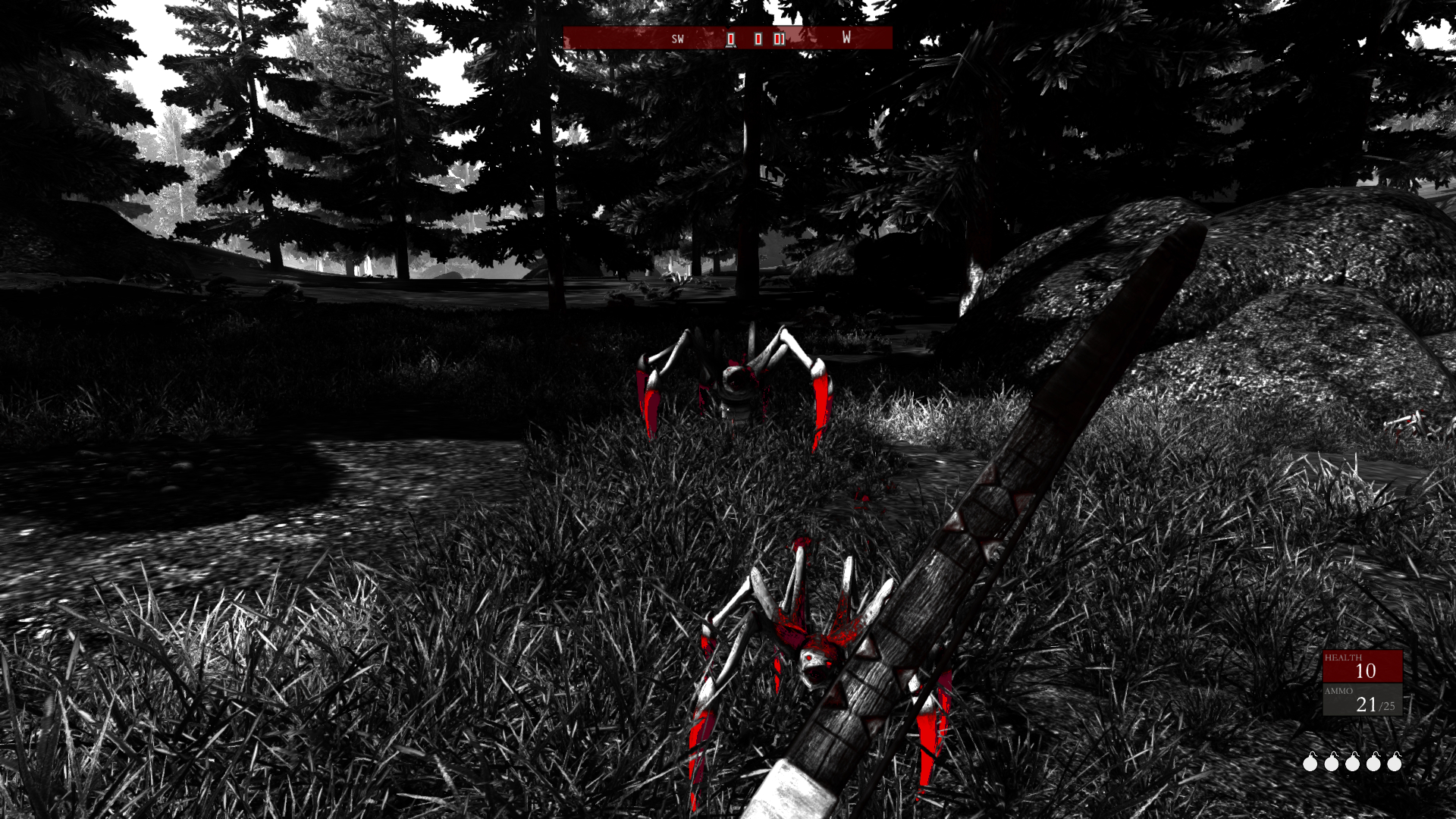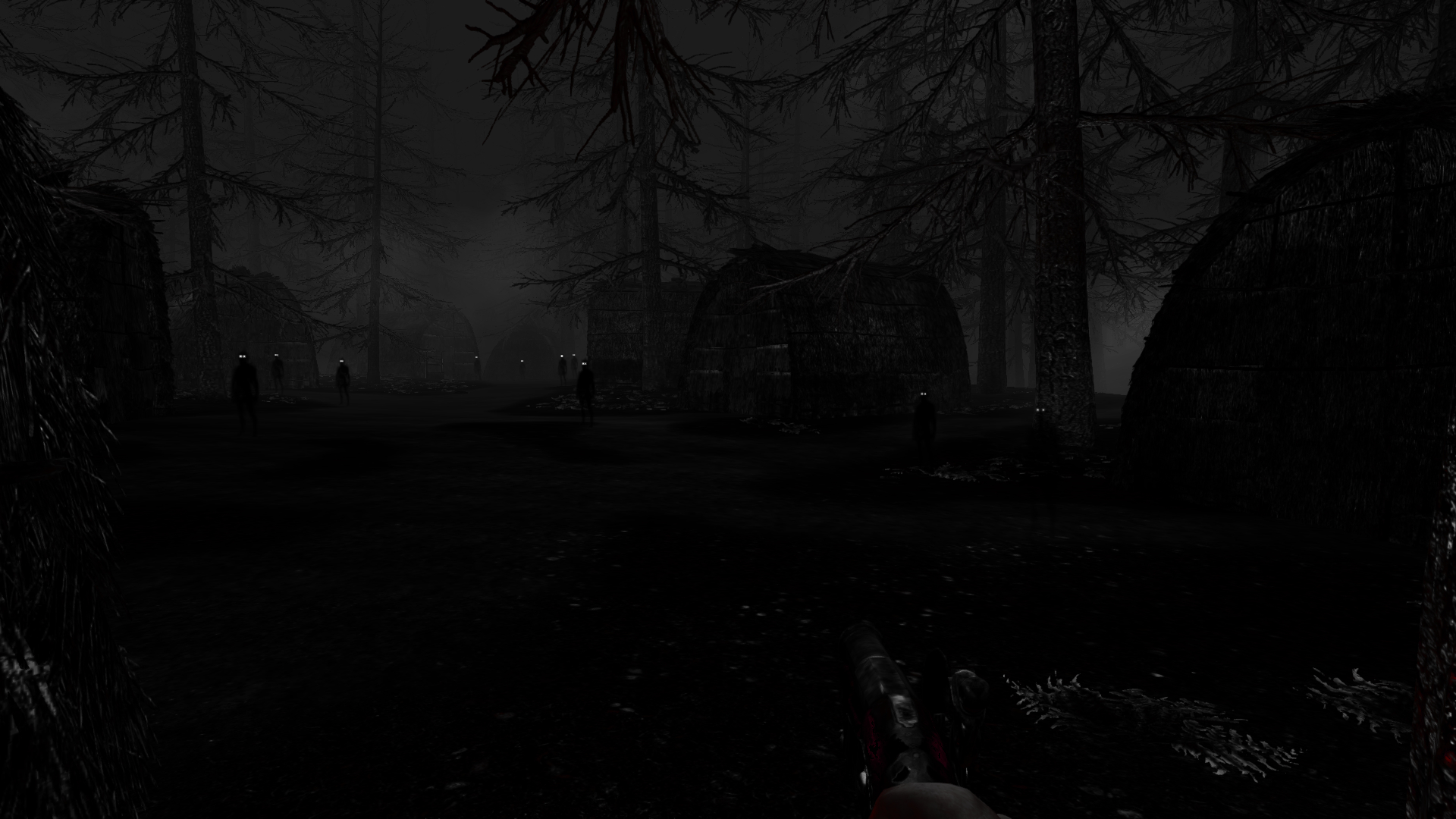
This post is going to be fairly… spoiler-heavy. Or, at the very least, revealing — about a game that’s better played while it’s still mysterious and strange. If you haven’t played Betrayer, I urge you to check it out before reading any further. Or if a more general overview would help, I’ve got you covered over here.
Today, we’re going to get into the meat of Betrayer. We’re going to talk about things that I couldn’t (or didn’t want to) bring up in my more surface-level review. I’ve finished a second playthrough, mulled over the experience for almost a month, and now I’m itching for a detailed critique. Also — I just love this game too much to leave it at one post.
Let’s begin with the most obvious part…
A World Without Color
Or rather, a world with one color: red.
Betrayer has your standard ingame sliders to adjust brightness or contrast, among a wealth of other display options, but what’s unique is the slider for how much color is in the game. You can make the game world look just like any other — if you want. But the monochrome style of Betrayer is a very deliberate choice, and I think you lose some vital element of the experience if you play it any other way.
The world of Betrayer has been sapped of its life, and the visuals reflect that. The colonists? Dead. The natives? Slaughtered. The Spaniards? Whatever they are, I don’t think it’s alive. The look of the world speaks to the deeper unrest. The looming dread. The sense that whatever happened here, it was bad. It’s not safe here, and it’s not over.
You may come to find Betrayer beautiful, but it’s beautiful in a not-quite-right sort of way. It’s a savage, dangerous kind of beauty, and the hints of red throughout the world only drive that sense home. The only color left here is the color of violence and betrayal.
While the game looks fairly good by modern standards, it’s the monochrome presentation that will make it timeless even as the rest of the visuals age. It’s not about poly counts, lighting effects, post-processing, or whatever people are concerned with these days. It may not quite hold up to its contemporaries from those angles, but Betrayer is beautiful because of its style. It knows what it wants to be and doesn’t try to be anything else.
And it’s a credit to the developers that you can play it on low or medium settings (as I did) and still be in awe of the visuals. Though I’ll admit the Otherworld loses a lot more of its fidelity on lower settings than the “real” world does.
The Sound of the Bell Will Guide You
Regarding sound, there’s not much to say other than it is phenomenal. It is so rare that we get to see a world like this, or a story that takes place in this time period, and the sound design makes the setting come alive. Jangling armor to tell you a soldier is prowling just behind that bush. Flags flapping overhead. The twang of a bowstring.
But it’s the soundscape outside of combat that really creates the mood — two distinct moods, actually. The contrast between Light and Dark worlds could not be more extreme. The wind rustling through the grass and the sound of birds in the swaying trees could almost make you feel at ease… if it weren’t for the monstrous growls and bestial roars of the Spanish soldiers hunting you. Then you take a trip into the Dark, and the cacophony of whispering spirits and screaming corpses and the bell ringing ringing ringing without end could drive you mad.
That’s to say nothing of the sound design central to the actual gameplay. A faint hum indicates a nearby collectable or bit of lore, but you also have a Listen key that will cause all plot-related objects or people in the area to send out an unmistakable cue to direct you in the right direction. Either way, you’d better have a good sound system and a quiet place to play. Betrayer, more than any game of its type that I’ve played, gives the same level of attention to the way its world sounds as it does to the way it looks.
More Beasts Than Men
In the world of Light, the Spaniards are your primary foe, and this is where you have your most tactical options. It takes a little while to gain access to all the weapons, but you’ll eventually have your choice of bows, crossbows, muskets, front-loading pistols, and even tomahawks and old-worldy grenades. You can have three weapons equipped at once (plus tomahawks and explosives), and the agonizingly slow reloads on half of them will force you to switch on the fly. Pick off the lead soldier with your musket… rapid-fire your short bow at the others as they try to close the distance… turn and tomahawk another who somehow managed to sneak up on you from behind.
I found that my ideal arsenal was a short bow, pistol, and crossbow. The short bow carried me through the bulk of combat, trading the long bow’s slightly longer range for an even faster rate of fire. Pistols were great for initiating close-range combat with a bang since they do the most damage of any weapon, reload way faster than muskets, and are basically the coolest thing ever. Then you’ve got a crossbow, which reloads pretty slowly and isn’t too useful in actual combat, but does stealth takedowns like nobody’s business — and at extreme range. And of course tomahawks and bombs for special occasions. The only weapon I frankly found useless was the musket, with its three year long reload animation and relatively unimpressive damage.
If head-on fights aren’t your thing, you can try to play it cool and quiet, picking your enemies off from the shadows, or using the wind mechanic to mask your footsteps as you charge in from behind. The stealth is simple but incredibly well-realized. It all feels satisfying — skulking in the tall grass and picking off Spaniards with an arrow to the head; waiting for the wind to pick up so you can sprint in, unheard, and stick a knife in their back; impaling a soldier with a long-range crossbow shot, then waiting for his friends to come investigate so you can do the same to them.
I found myself cherishing the simple moments. Panicking after my perfectly placed arrow ricochets off a helmet and goes spinning wildly into the air. Firing a muzzle-loaded pistol from the hip — and dropping a Spaniard at twenty yards. Finding a bunch of my stray arrows lodged in a tree on the next ridge after a heated battle.
Where it begins to fall apart is in the Otherworld. Stealth is almost eliminated, with enemies often spawning in all around you, immediately aware of your position. There are skeletons wandering in the darkness that you can sneak up on — if you manage to see them before they see you, but the thick fog will generally mean you don’t. They’re also not that threatening; the real meat of the Otherworld are the big melees that ensue when you try to cleanse the world’s many corrupted totems and a horde of skeletons and masked spirits come rushing in to stop you. These battles are always fun, but tactically not that interesting — and you’ll be seeing a whole lot of them.
Still, overall I do love the combat in Betrayer. It’s just a shame that most of your time is spent in the Otherworld rather than the world of Light — because the Spaniards are just a joy to fight. I wish the enemy rush battles of the Otherworld had been a special, rare thing rather than being the main encounters in the game.
Ghost Stories
Now we come to the most important part.
Stories are far more important to Betrayer than you expect, and I say stories — plural — for good reason. An overarching storyline is there, but it’s only really addressed at the end. Who is the Maiden in Red? You’ll have to wait until then. What happened to the colony? In a general sense, you’ll also discover that at the end too.
But what happened to the colonists — as individuals? This is what you have to piece together over the course of the game. They all have their own stories, often completely unrelated, tied together merely by a common theme.
The Otherworld is home to the spirits of the colonists, clinging to this strange, foreign land where they met their end. In each of the game’s zones, you’ll find a number of spirits whose fates were all intertwined, and it’s your job to figure out how.
First you’ll have to jog their memories, whether by presenting them with a physical object from their lives, or by reminding them of the events that led to their death. What this boils down to, unfortunately, is hitting the Listen key, walking in the direction it points you until you find something to pick up or a spirit to talk to, and then doing that again. Over and over. You find an empty scabbard or a bit of torn clothing or a branch crusted with blood, give it to the ghost of one of the colonists, hear a cryptic description of what happened to him or her, and then go tell another ghost what you heard so they can fill in more of the story. Eventually you’ll work out all the angles and get the full picture of what happened in this area, and then you’ll move on to the next.
It’s okay if you think that sounds boring and repetitive. It is repetitive. But boring? — not so much. I’ll admit that the manner in which you uncover the stories of the colonists could be way, way more compelling, but the stories themselves will keep you hooked regardless. The more I learned, the more I wanted to know. The tragic, the infuriating, the heartbreaking, I wanted to understand why and how it had come to this.
The dialogue is so masterfully written that it takes very little to get you completely invested in the tales the colonists have to tell. There’s no voice acting, and the text blurbs themselves are actually quite short, but that makes them all the more powerful. In just a few words, so much emotion can be conveyed that it blows my mind. I was hit with so many emotions so rapidly that I didn’t really understand how to process them. These people have done horrific things, but you always at some level understand why. Even if you don’t condone what they did, you can see how a person would have made the decisions that they made.
And writing justification for some of the acts of depravity here could not have been easy.
Of course, the human side of things isn’t the only thing that’s justified. So many of the game’s little details or minor plot elements are explained somewhere. Even the dumb little gameisms are all handwaved away by some really clever note or throwaway line of dialogue.
The treasure chests scattered across the countryside? The Lord Governor ordered them hidden away when unexplainable ghostly shapes begin encroaching on his settlements.
The bell you have to go find half a mile from where it’s supposed to be hanging? Stolen by a hunter who thought its tolling was spooking his prey.
The skull-wearing wraiths and the spirits who are wandering in search of their heads? Even that’s kind of explained at one point.
There’s just one glaring exception…
Giant Spiders
Sorry, Blackpowder, but we can’t gloss over this part. There is nothing that could possibly be more out of place, nothing that could be more cartoonishly over the top, nothing that could more quickly rip me out of the experience and scream “YOU’RE PLAYING A VIDEOGAME, REMEMBER?” than this. And they’re probably the only thing that isn’t cleverly justified in some note or bit of dialogue somewhere. Why are there giant spiders in this game?
No, seriously. Why. I need an answer to this or you’re going to find me dead of an aneurism.
You can’t just throw huge mutant spiders into a game that’s otherwise all spooky paranormal stuff. Every other enemy is some form of ghost or undead creature or possessed human, and then there’s just… spiders. Big, dumb, venom-spitting monster spiders.
Great.
Also, while we’re on the topic of really silly decisions, honorable mention goes to that incredible BOONK sound effect when arrows deflect off of armor — which I’m pretty sure was lifted straight out of Tom and Jerry.
Unanswered Questions
Here come the real, actual spoilers. If you haven’t finished the game, please please don’t read any further.
I’ve heard a lot of people asking for more answers. In the form of DLC or a sequel, or directly from the mouths of the devs themselves. And it’s true — there are a lot of questions left unanswered in the end. Less than you think if you haven’t read all the notes and taken a bit of time to connect some dots for yourself. But there are definitely questions.
Who the heck was John Howe? Allison supposedly survived because Tabitha spared her, but what about Howe? He’s clearly still alive; his notes are written specifically for you, and his final message claims he’s being hunted. He’s the only human aside from you and Allison who is alive. Did he get here late, like you did?
Who did all this? Tabitha or Allison? Both? On the surface, everything seems to be Tabitha’s work, but Allison has the power to send you to the Otherworld, and perhaps to call the giants to her aid. Could it be that Tabitha was just collateral damage, taking the blame when Allison began to test out the powers the giants had given her?
And what happens now — to Allison and to the player character? The ending very overtly implies that Allison sics the giants on you, and given that they seem to be the source of all the paranormal insanity going on, I seriously doubt you’d survive an encounter with them. The post-credits free-roam mode contradicts this, though, with the player character still being alive, there being no mention of the giants, and Allison being on friendly terms with you again. I don’t know if that part should be taken as a continuation of the story or if it’s just a dumb attempt at justifying the fact that the devs wanted you to be free to explore the game after the utter finality of the ending.
But to be honest, I don’t really want answers to most of the questions I had. There’s enough in the way of backstory and explanation that the story feels complete, and any gaps appear deliberate. I’ve had an absolute blast bouncing ideas around with other people who’ve played the game, sharing our takes on it and trying to to fill in those gaps. I’d rather a plot that leaves some mystery than one that ties every loose end.
If I want a sequel — and I’ve thought a lot about this and still haven’t decided if I really do — it’s because I want to spend more time in this world, not because I want to have my questions answered. I want to walk the coastline and watch glittering silver water wash up among the black and white stones. I want to see how the countryside looks come winter — to level a crossbow at a flaming ash figure barreling down on me through the snow. I want to see through the eyes of the natives. I want to go to that forbidden place where the giants once lived.
The worst thing a sequel could do is to answer too many questions — to shatter the sense of mystery and of the unknown. And I worry that having two Betrayers would make the whole experience feel less unique. Less special. Maybe I wouldn’t be so desperately in love with the game if I knew there were more like it. But gosh dang does part of me wish there were.
